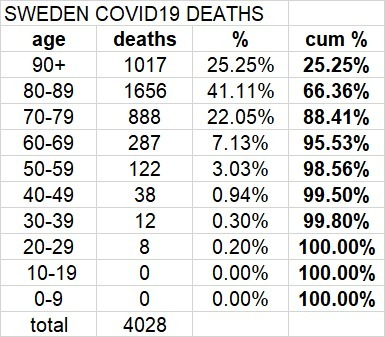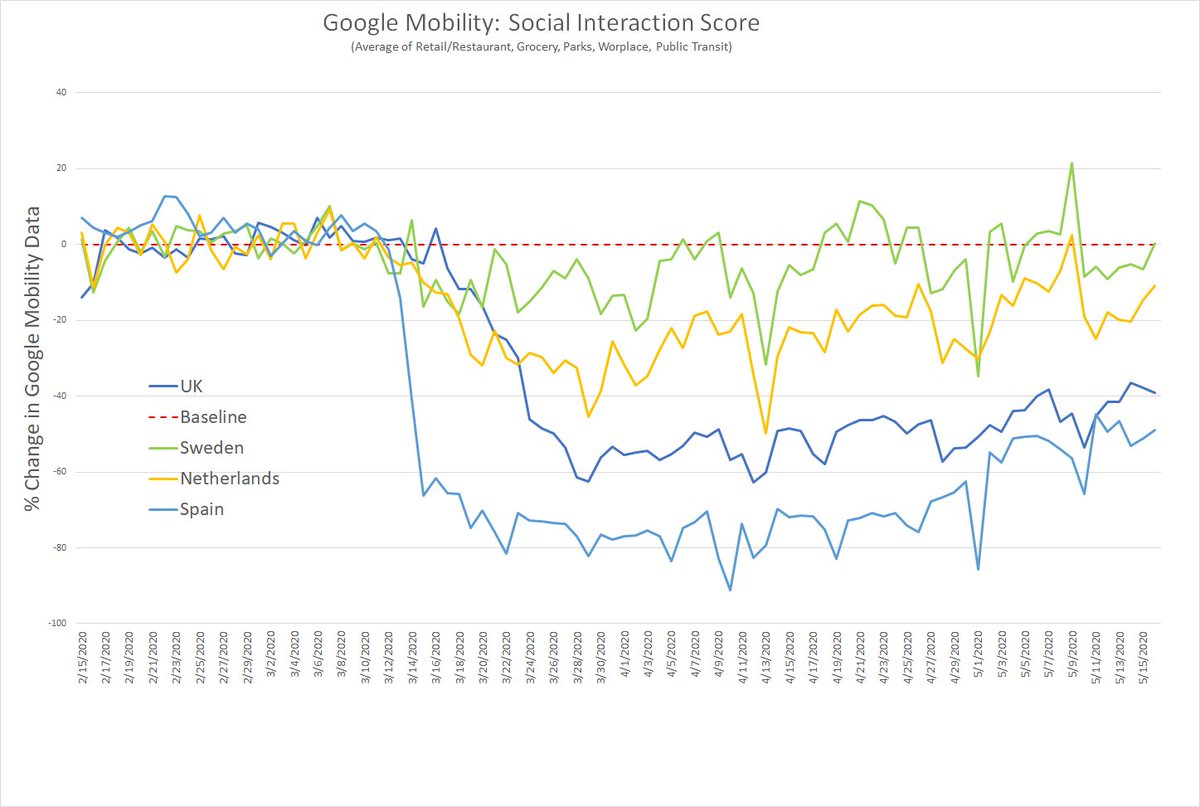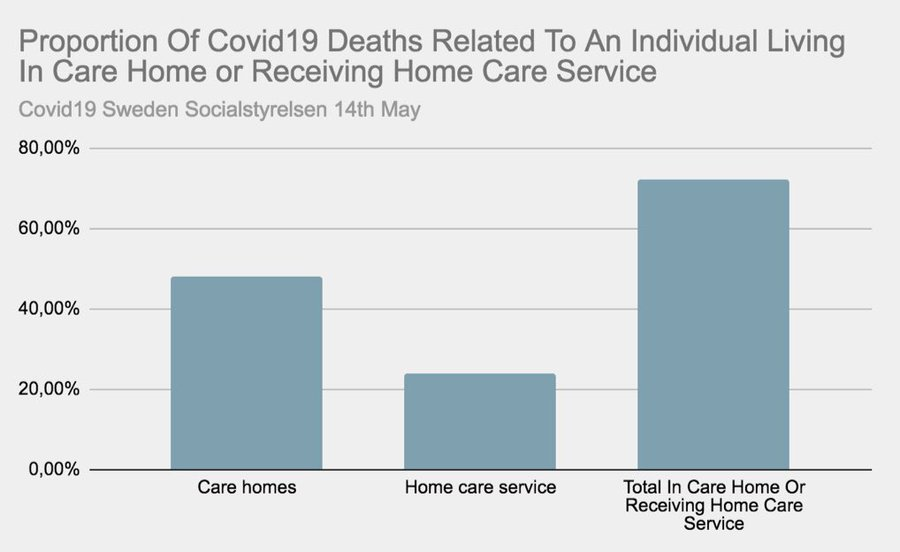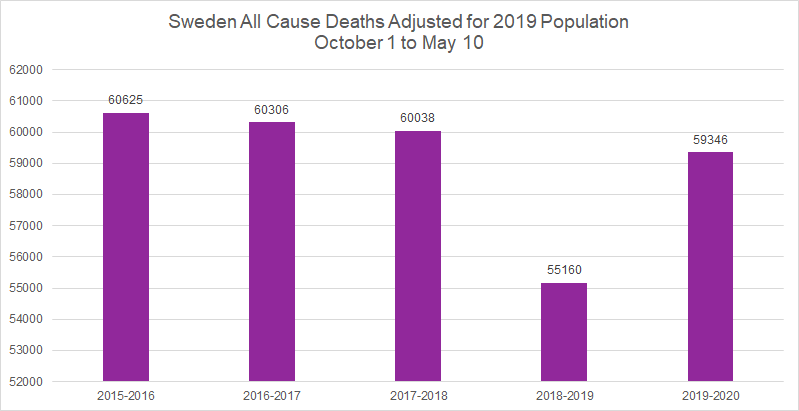sweden& #39;s position in these rankings has invited a great deal of criticism for not locking down (despite being surrounded on that list by other countries that did)
an intriguing question is "could lockdown possibly have worked?"
the answer seems to be "not really".
let& #39;s look.
an intriguing question is "could lockdown possibly have worked?"
the answer seems to be "not really".
let& #39;s look.
demographically, deaths show a very stark picture:
88% of deaths were in those over the age of 70.
given this demographic pattern, how much good could keeping people under 70 home possibly have done even if doing so did work?
best case is it reduced deaths 12%.
88% of deaths were in those over the age of 70.
given this demographic pattern, how much good could keeping people under 70 home possibly have done even if doing so did work?
best case is it reduced deaths 12%.
and that 12% drop, which would literally not move sweden even one position on the deaths per million ranking table, would require lockdowns to be 100% effective in stopping deaths.
no one believes that.
so just where is the case here that sweden needed societal lockdown?
no one believes that.
so just where is the case here that sweden needed societal lockdown?
it& #39;s just not plausible that letting most of sweden run around free caused more significantly deaths
58 people under 50 y/o died in the whole country
that& #39;s 8 in a million. 0.0008%
0 younger than 20 died
how can anyone make a case for closing schools and offices from that?
58 people under 50 y/o died in the whole country
that& #39;s 8 in a million. 0.0008%
0 younger than 20 died
how can anyone make a case for closing schools and offices from that?
467 people under the age of 70 died of COV over 10 wks. that& #39;s 47 a wk.
1729 swedes a die each wk (avg of 2015-19 over same 10 week period)
despite being out and about, this just did not drive deaths in swedens young
(and they were out and about)
google mobility shows us so
1729 swedes a die each wk (avg of 2015-19 over same 10 week period)
despite being out and about, this just did not drive deaths in swedens young
(and they were out and about)
google mobility shows us so
so what is going on here? we have high reported deaths per million, lots of older deaths, and none among the young.
this points to 2 possibilities: either there was some nasty blunder in elder care policy or deaths are being over-counted.
which does the data fit best?
this points to 2 possibilities: either there was some nasty blunder in elder care policy or deaths are being over-counted.
which does the data fit best?
70% of swedish deaths seem to be in nursing homes or in people subject to elder care.
this has led many to presume that sweden must have blundered akin to cuomo in NY or italy or spain.
possible, but i find it less plausible than the alternative that deaths are over-counted.
this has led many to presume that sweden must have blundered akin to cuomo in NY or italy or spain.
possible, but i find it less plausible than the alternative that deaths are over-counted.
here& #39;s why: we do not see high overall deaths.
when we look at all cause deaths in sweden over this flu season (from the SCB) on a population adjusted basis this year is the second lowest death rate of the last 5.
it& #39;s 2 full percentage points lower than 2015-16.
when we look at all cause deaths in sweden over this flu season (from the SCB) on a population adjusted basis this year is the second lowest death rate of the last 5.
it& #39;s 2 full percentage points lower than 2015-16.
if COV were killing a lot of people who wouldn& #39;t otherwise have died, we& #39;d see it in overall deaths
the fact that we don& #39;t may mean that we& #39;re seeing a definitional issue
if elder care services are marking every death that might be covid as cov, this is what it would look like
the fact that we don& #39;t may mean that we& #39;re seeing a definitional issue
if elder care services are marking every death that might be covid as cov, this is what it would look like
you& #39;re dying of pneumonia or cancer or old age and you happen to also get covid. so you die "with" covid (or suspected covid) but not really "from" it.
but they call it covid. so the covid death count looks high, but overall deaths do not.
the pattern fits.
it& #39;s suggestive.
but they call it covid. so the covid death count looks high, but overall deaths do not.
the pattern fits.
it& #39;s suggestive.
but, it does not fit so well that we can exclude the other possibility which is that sweden, like the ROW, had a very mild flu season leading to fewer than expected deaths, then covid caused rapid mean reversion by hitting a large cohort of the unusually vulnerable
but neither presents an even remotely plausible case for lockdowns or that stopping people under the age of 70 from running around free could have made any material difference even if lockdowns were 100% effective (and they aren& #39;t).
so what& #39;s the case here?
so what& #39;s the case here?
how can one possibly argue that 30 year olds in bars, 40 year olds at work, and kids at school had any serious effect on the death rate in sweden?
it seems impossible.
it was either an elder care blunder or it& #39;s overcounting of deaths BY eldercare.
it seems impossible.
it was either an elder care blunder or it& #39;s overcounting of deaths BY eldercare.
if you have some info on how sweden did or did not handle elder care well or that they are being agressive in marking deaths COV and that this is skewing numbers, i& #39;d love to see the info.
thanks.
thanks.

 Read on Twitter
Read on Twitter






